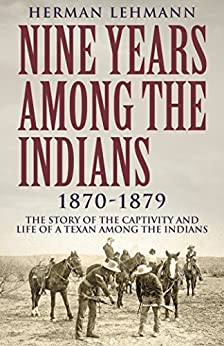Nine Years Among the Indians, 1870-1879: The Story of the Captivity and Life of a Texan Among the Indians by Herman Lehmann and edited by J. Marvin Hunter was first published in 1927, though I read the 2017 edition. J. Marvin Hunter personally knew Herman Lehmann, and this marvelous account is presented as given to Hunter “without exaggeration, nor boasting, with the hope that the reader will find it interesting and a true recital of facts.” And that’s exactly how I found this read, plus gaining a far greater understanding of the Indian’s plight.
Herman Lehmann was captured by a band of Apache Indians when he was about eleven years old. His first several months were grueling with cruel treatment and sometimes scant food. Eventually, he was accepted into the tribe, forgot the white man’s ways and became a fierce warrior, plundering horses and property and killing the white man who had robbed them of hunting grounds, destroyed game, and brought disease.
Four years later, when he was about fifteen, he had a misunderstanding with members of the tribe and struck out on his own, living in the wilderness for about a year.
He came upon a band of Comanches and was eventually adopted by them. During that time he met Quanah Parker, a leader of a Comanche band called Kwahadi. By this time Lehmann had forgotten his own language and was totally immersed into Indian culture.
The book contains many interesting facts such as Indians weren’t particularly afraid of regular army soldiers, but dreaded Texas Rangers and frontiersmen whose guns were always loaded and their aim unerring. Another observation I found interesting was that Lehmann found the Comanche a fun-loving people and enjoyed a good laugh, while the Apaches were morose and never laughed except when someone was hurt or calamity befell them. Another interesting tidbit was that the Apache were characteristically silent, while the Comanche shouted and yelled, making all the noise possible.
In 1878, Herman was brought back to the white man’s world. At first he rejected life there, even though he was with his widowed mother, brothers and sisters. He didn’t remember any of them and couldn’t even converse in their language. Eventually he accepted their ways, married and became a good citizen, though he still retained his Comanche tribal rights and privileges, and remained a friend of Quanah Parker.
I have read many accounts of captured whites, many of whom preferred to remain with the Indians who had become family to them. This account is perhaps one of the most famous of the captivity stories. Though it has some gruesome scenes, it has a ring of authenticity. I found Herman Lehmann’s account of his nine years with the Indians riveting.


